A Review of Research Progress on Soil Organic Cover Machinery in China
Abstract
:1. Introduction
2. Review of Typical Soil Organic Cover Machinery
2.1. Straw Chopper and Spreader
2.1.1. The Chopping Device
| Core Device | Common Form | Schematic | Features |
|---|---|---|---|
| Chopper | Flapping type [31] | 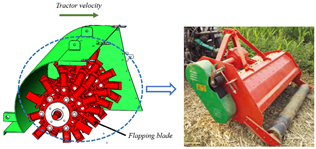 | Suitable for wheat and rice straw; low fuel consumption; simple structure. |
| Chopping and fixed blade [23] | 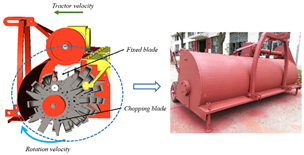 | Suitable for maize, wheat, and rice straw; good chopping quality; wide range of application. | |
| Chopping blade [32] | 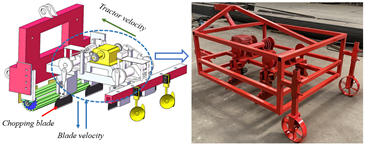 | Suitable for maize and cotton straw; small length of chopped straw. | |
| Double rollers [33] | 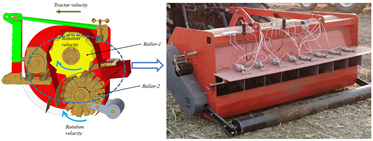 | Suitable for various types of crop straw; high chopping quality. |
2.1.2. The Spreading Device
2.2. Rotary Tiller
| Core Device | Common Form | Schematic | Features |
|---|---|---|---|
| Rotary tiller | Horizontal rotary tiller in downcutting [41] | 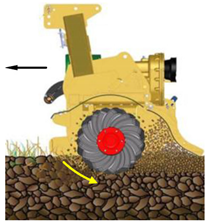 | Low fuel consumption; wide range of application. |
| Horizontal rotary tiller in upcutting [41] |  | High chopping quality; high fuel consumption; suitable for hard soil. | |
| Vertical rotary tiller [41] | 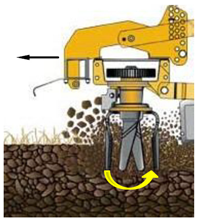 | Strong soil crushing ability; high work quality. |
2.3. Plow
3. Key Parts of Soil Organic Cover Machinery
3.1. Blades
3.2. Discs
3.3. Moldboards
4. Advanced Computing Methods of Simulating and Predicting Machine Performance
4.1. Finite Element Analysis
4.2. Discrete Element Method
4.3. Mechanics Analysis Method
5. Discussion and Future Work
5.1. The Effects of Soil Organic Cover Should Be Further Clarified
5.2. The Selection of Technical Patterns Should Be More Suitable
5.3. The Performance of the Machines Should Be Further Improved
6. Conclusions
- (a)
- Choosing different types of machinery according to different crops and planting patterns could improve working quality and efficacy.
- (b)
- Redesigning or optimizing the key parts of soil organic cover machinery could improve machinery performance and reduce fuel consumption. The machinery could be redesigned or optimized in regards to shape, working velocity, and installation location.
- (c)
- Selecting advanced computing methods could help us simulate and predict machine performance. In addition, choosing a proper computing method could tremendously reduce computing time.
Author Contributions
Funding
Institutional Review Board Statement
Informed Consent Statement
Data Availability Statement
Conflicts of Interest
References
- Zulfiqar, U.; Hussain, S.; Ishfaq, M.; Ali, N.; Ahmad, M.; Ihsan, F.; Sheteiwy, M.S.; Rauf, A.; Hano, C.; EI-Esawi, M.A. Manganese Supply Improves Bread Wheat Productivity, Economic Returns and Grain Biofortification under Conventional and No Tillage Systems. Agriculture 2021, 11, 142. [Google Scholar] [CrossRef]
- Lou, S.Y.; He, J.; Li, H.W.; Wang, Q.J.; Lu, C.Y.; Liu, W.Z.; Liu, P.; Zhang, Z.G.; Li, H. Current Knowledge and Future Directions for Improving Subsoiling Quality and Reducing Energy Consumption in Conservation Fields. Agriculture 2021, 11, 575. [Google Scholar] [CrossRef]
- Jules, P. Intensification for Redesigned and Sustainable Agricultural Systems. Science 2018, 362, 908. [Google Scholar] [CrossRef]
- FAO. Conservation Agriculture. Available online: https://www.fao.org/conservation-agriculture/en/ (accessed on 18 August 2022).
- Manuel, L.V.; Elena, C.S.; Sara, A.; Artemi, C. Effectiveness of Cover Crops to Reduce Loss of Soil Organic Matter in a Rainfed Vineyard. Land 2020, 9, 230. [Google Scholar] [CrossRef]
- Martínez-García, L.B.; Korthals, G.; Brussaard, L.; JoRgensen, H.B.; Deyn, G.D. Organic management and cover crop species steer soil microbial community structure and functionality along with soil organic matter properties. Agric. Ecosyst. Environ. 2018, 263, 7–17. [Google Scholar] [CrossRef]
- Kopila, S.C.; Shikha, S.; Brianna, R.W.; Sandeep, K.; Juan, D.P.G. Cover Crops and Returning Residue Impact on Soil Organic Carbon, Bulk Density, Penetration Resistance, Water Retention, Infiltration, and Soybean Yield. Agron. J. 2018, 110, 99–108. Available online: https://digitalcommons.unl.edu/usdaarsfacpub/2139 (accessed on 18 August 2022).
- Che, F.W.; Li, S.Y.; Sun, X.Y.; Qu, B.P.; Yun, B.H.; Wang, X.Y.; Xiong, K.Y. Effect of Different Organic Materials Mulching on Moisture Holding Capacity of Soil. Bull. Soil Water Conserv. 2020, 40, 182–187. [Google Scholar] [CrossRef]
- Novara, A.; Minacapilli, M.; Santoro, A.; Rodrigo-Comino, J.; Carrubba, A.; Sarno, M.; Venezia, G.; Gristina, L. Real cover crops contribution to soil organic carbon sequestration in sloping vineyard. Sci. Total Environ. 2019, 652, 300–306. [Google Scholar] [CrossRef]
- Kaye, J.P.; Quemada, M. Using Cover Crops to Mitigate and Adapt to Climate Change. A Review. Agron. Sustain. Dev. 2017, 37, 4. [Google Scholar] [CrossRef]
- Faulkner, E.H. Plowman’s Folly; Michael Joseph: London, UK, 1943. [Google Scholar]
- Friedrich, T.; Derpsch, R.; Kassam, A.H. Global overview of the spread of conservation agriculture. Field Actions Sci. Rep. 2012, 6, 1–7. [Google Scholar]
- Derpsch, R.; Friedrich, T.; Kassam, A.; Li, H.W. Current status of adoption of no-till farming in the world and some of its main benefits. Int. J. Agric. Biol. Eng. 2010, 3, 1–26. [Google Scholar]
- Central People’s Government of the People’s Republic of China. Seven Departments Jointly Issued the “National Black Soil Protection Project Implementation Plan (2021–2025)”. Available online: http://www.gov.cn/xinwen/2021-07/30/content_5628527.htm (accessed on 22 March 2022).
- Chinese Academy of Sciences. Outline of Northeast Black Soil Protection Plan (2017–2030). Available online: https://www.cas.cn/zt/kjzt/htlc/htzc/202105/t20210512_4787740.shtml (accessed on 22 March 2022).
- Ministry of Agriculture and Rural Affairs. Action Plan for Conservation Tillage of Black Soil in Northeast China (2020–2025). Available online: http://www.moa.gov.cn/gk/tzgg_1/tz/202003/t20200318_6339304.htm (accessed on 22 March 2022).
- Ministry of Agriculture and Rural Affairs. Technical Guidelines for Green Agricultural Development (2018–2030). Available online: http://www.moa.gov.cn/gk/ghjh_1/201807/t20180706_6153629.htm (accessed on 22 March 2022).
- Ministry of Agriculture and Rural Affairs. Focus on the 2020 Central Document No. 1. Available online: http://www.moa.gov.cn/ztzl/jj2020zyyhwj/ (accessed on 22 March 2022).
- Li, F.D.; Yin, C.B. Assessment of the functions and ecological services values of green manure in paddy fields in South China. Chin. J. Eco-Agric. 2019, 27, 327–336. [Google Scholar] [CrossRef]
- Wang, D.W.; Wang, W.; Liao, J.A.; Yi, X.K.; Li, P.; He, Y.C.; Zhang, F.K.; Wu, H.C. Incorporation process of green manure in North China and current countermeasures of related machinery. Pratacult. Sci. 2020, 37, 2152–2164. [Google Scholar] [CrossRef]
- Sun, N.N.; Wang, X.Y.; Li, H.W.; Peng, X.L.; Wang, J.; Wang, Q.J. Performance of straw returning equipment under different mechanized straw returning pattern in Northeast rice area. Trans. Chin. Soc. Agric. Mach. 2018, 49, 68–74. [Google Scholar] [CrossRef]
- Yang, Q.L.; Chen, G.B.; Xie, L.J.; Wang, Q.J.; He, J.; Li, H.W. Design and Experiment of Telescopic Finger Stalk of Maize Straw Burying Machine. Trans. Chin. Soc. Agric. Mach. 2020, 51, 35–43. [Google Scholar] [CrossRef]
- Zhang, Z.Q.; He, J.; Li, H.W.; Wang, Q.J.; Ju, J.W.; Yan, X.L. Design and Experiment on Straw Chopper Cum Spreader with Adjustable Spreading Device. Trans. Chin. Soc. Agric. Mach. 2017, 48, 76–87. [Google Scholar] [CrossRef]
- Wang, Q.J.; Liu, Z.D.; He, J.; Li, H.W.; Li, W.Y.; He, J.H.; Yan, X.L. Design and experiment of chopping type maize straw returning machine. Trans. Chin. Soc. Agric. Eng. 2018, 34, 10–17. [Google Scholar] [CrossRef]
- Kaiyuan Magic Knife 1FXG-220 Straw Turning Machine. Hebei Shuangtian Machinery Manufacturing Co., Ltd. Available online: https://shuangtian.nongji1688.com/sell/itemid-5465422.shtml (accessed on 22 March 2022).
- Lianhang-4JQ-440 Zhaoxian Lianhang Machinery Co., Ltd., Hebei Lianhang Machinery Co., Ltd. Available online: https://wd.nongji360.com/product/view?id=104941&dmname=shop57058628 (accessed on 22 March 2022).
- Machines. YTO Group Corporation. Available online: http://www.yituo.com.cn/cpzx/jjcp/ (accessed on 22 March 2022).
- Sun, N.N.; Wang, X.Y.; Li, H.W.; He, J.; Wang, Q.J.; Wang, J.; Liu, Z.D.; Wang, Y.B. Design and experiment of differential sawing rice straw chopper for turning to field. Trans. Chin. Soc. Agric. Eng. 2019, 35, 267–276. [Google Scholar] [CrossRef]
- Bao, X.L.; Yan, Y.; Mao, J.C.; Tian, F.Y.; Meng, L. Design and analyses of seinging blade for orchard mowing robot. J. Huazhong Agric. Univ. 2020, 39, 136–143. [Google Scholar] [CrossRef]
- Liu, P.; He, J.; Lou, S.Y.; Wang, Y.B.; Zhang, Z.G.; Lin, H. Design and Experiment for Dynamic Supporting Type Maize Straw Chopping Retention Device with Different Rotation Speeds of Disc Blade. Trans. Chin. Soc. Agric. Mach. 2021, 52, 41–50. [Google Scholar] [CrossRef]
- Zheng, Z.Q.; He, J.; Li, H.W.; Diao, P.S.; Wang, Q.J.; Zhang, X.C. Design and Experiment of Straw-chopping Device with Chopping and Fixed Knife Supported Slide Cutting. Trans. Chin. Soc. Agric. Mach. 2016, 47, 108–116. [Google Scholar] [CrossRef]
- Lin, H.; He, J.; Li, H.W.; Wang, Q.J.; Lu, C.Y.; Yang, W.C.; Huang, S.H.; Liu, P.; Chang, Y.B. Design and Experiment of a Reciprocating Intermittent Chopping Device for Maize Straw Returning. Agriculture 2022, 12, 220. [Google Scholar] [CrossRef]
- Liu, P.; He, J.; Li, Y.J.; Li, H.W.; Wang, Q.J.; Lu, C.Y.; Zhang, Z.G.; Li, S.H. Design and experiment of double rollers maize stalk chopping device with different rotation speeds. Trans. Chin. Soc. Agric. Eng. 2020, 36, 69–79. [Google Scholar] [CrossRef]
- Liu, K.; Tao, L.; Liu, Y.; Zhou, P.; Yin, W.Q. Development of a straw chopping and throwing device for a fully fed rice-wheat combine harvester. Jiangsu Agri. Mech. 2016, 6, 31–33. [Google Scholar] [CrossRef]
- Humphreys, E.; Blackwell, J.; Sidhu, H.S.; Malkeet-Singh, S.S.; Manpreet-Singh, Y.S.; Anderson, L. Direct drilling into stubbles with the Happy Seeder. IREC Farmers’ Newsl. Large Area 2007, 172, 4–7. [Google Scholar]
- Ju, J.W.; Zhou, J.K.; He, J.; Li, H.W.; Wang, Q.J.; Lu, C.Y.; Peng, L. Design and experiment on the combined machine for variable straw chopping-cover and mixed-burying. Int. Agric. Eng. J. 2020, 29, 12–18. [Google Scholar]
- Zheng, Z.Q.; He, J.; Wang, Q.J.; Li, H.W.; Li, W.Y.; Chen, W.Z. Design and Experiment on Straw Pickup-chopping and Ditch-burying Integrated Machine. Trans. Chin. Soc. Agric. Mach. 2017, 48, 87–96. [Google Scholar] [CrossRef]
- Matin, M.A.; Desbiolles, J.M.A.; Fielke, J.M. Strip-tillage using rotating straight blades: Effect of cutting edge geometry on furrow parameters. Soil Tillage Res. 2016, 155, 271–279. [Google Scholar] [CrossRef]
- Sun, W.C.; Liao, Q.X.; Zhang, Q.S.; Bu, X.L.; Wei, G.L.; He, K. Design and field test of rapeseed direct-seeding seedbed preparation machine combined driving type disc ploughing with reverse rotary tilling. J. Huazhong Agric. Uni. 2021, 40, 67–76. [Google Scholar] [CrossRef]
- Albiero, D.; Maciel, A.J.S.; Monteiro, L.A.; Lancas, K.P.; Gamero, C.A.; Melo, R.P.; Araujo, M.C. Effects in Mechanical Properties and Structure of the Soil After Tillage with Rotary Paraplow. Afr. J. Agric. Res. 2014, 9, 1855–1866. [Google Scholar] [CrossRef]
- Zheng, K. Study on Subsoiling and Rotary Tillage Operation Adjustable Combine Machine; China Agricultural University: Beijing, China, 2018; Volume 1, pp. 2–14. [Google Scholar]
- Zhao, X.Y. Design and Experiment of Straw Plowing and Rotary Combined Tiller; China Agricultural University: Beijing, China, 2017; Volume 1, pp. 2–15. [Google Scholar]
- GB/T 14225–2008; Moldboard Plough. National Standardization Administration Committee of China. General Administration of Quality Supervision, Inspection and Quarantine of the People’s Republic of China. China Standard Press: Beijing, China, 2008.
- Liu, X.P.; Zhang, Q.S.; Xiao, W.L.; Ma, L.; Liu, L.C.; Liao, Q.X. Design and experiment on symmetrical driven disc plows combined tillage machine for rice-rapeseed rotation area. Trans. Chin. Soc. Agric. Mach. 2017, 48, 33–41. [Google Scholar] [CrossRef]
- Okoko, P.; Ajav, E.A. Determination of Draft Force for a 3-bottom Disc Plough under Sandy Loam Soil Conditions. Am. J. Agric. Biol. Sci. 2020, 15, 60–67. [Google Scholar] [CrossRef]
- Liu, X.L. Design and Experiment of the New Smashed Straw Machine Blade; Jilin University: Changchun, China, 2012; Volume 1, pp. 1–30. [Google Scholar]
- He, C.B.; You, Y.; Wang, D.C.; Wang, G.H.; Lu, D.H.; John, M.T.K. The effect of tine geometry during vertical movement on soil penetration resistance using finite element analysis. Comput. Electron. Agric. 2016, 130, 97–108. [Google Scholar] [CrossRef]
- Gan, S.B.; Li, Y.; Zhang, X.R.; Zhang, G.J.; Wang, N. Design and experiment on banana stalk chopper with feeding type spindle flail. Trans. Chin. Soc. Agric. Eng. 2014, 30, 10–19. [Google Scholar] [CrossRef]
- He, N.B.; Li, Y.; Guo, C.F.; Zhang, X.R.; Liang, D. Optimization Design and Test of Blade of Banana Straw Returning Machine. J. Agric. Mech. Res. 2021, 43, 85–91. [Google Scholar] [CrossRef]
- Xu, C.H.; Jie, Z. Design of t-type plate knife roller of straw returning machine. Tract. Farm Transp. 2014, 41, 50–54. [Google Scholar]
- Li, G.; Li, Y.; Zhang, X.R.; Wu, X.S.; Sun, J. Design on the flail of straw chopper machine to field. J. Agric. Mech. Res. 2014, 8, 122–125. [Google Scholar] [CrossRef]
- Jia, H.L.; Liu, X.L.; Qi, J.T.; Ma, Y.H.; Ma, C.L.; Di, Y.K.; Yu, L.L.; Wu, H.; Pan, C.X. V-L Shape Straw Crushing and Returning Blade. China Patent 201110115590.9, 3 April 2013. [Google Scholar]
- Xu, W.; Cao, C.P.; Sun, Y. Optimization Ddesign of Hammer Structure Parameters of Hammer Mill. J. Agric. Mech. Res. 2021, 43, 27–33. [Google Scholar] [CrossRef]
- Liu, P.; He, J.; Li, H.; Wang, Q.; Lu, C.; Lou, S.; Wang, Y.; Lin, H.; Li, H.; Zhang, Z. Effects of various edge-curve types and rotational speeds of disc blades on breaking force and energy consumption in the maize stalk chopping process. Am. Soc. Agric. Biol. Eng. 2021, 37, 951–965. [Google Scholar] [CrossRef]
- Jia, H.; Jiang, X.; Guo, M.; Liu, X.; Wang, L. Design and experiment of V-L shaped smashed straw blade. Trans. Chin. Soc. Agric. Eng. 2015, 31, 28–33. [Google Scholar] [CrossRef]
- Zhao, H.B.; He, J.; Li, H.W.; Liu, C.G.; Zheng, K.; Zhang, Z.Q. Design and experiment of strip rotary-cut-throw anti-blocking implement. Trans. Chin. Soc. Agric. Mach. 2018, 49, 65–75. [Google Scholar] [CrossRef]
- Zhao, H.B.; Li, H.W.; Ma, S.C.; He, J.; Wang, Q.J.; Lu, C.Y.; Zheng, Z.Q.; Zhang, C. The effect of various edge-curve types of plain-straight blades for strip tillage seeding on torque and soil disturbance using DEM. Soil Tillage Res. 2020, 202, 104674. [Google Scholar] [CrossRef]
- Li, W.L.; Zhang, J.B.; Yang, C.H.; Liu, X.D.; Jiang, Q.C.; Liu, M.P. Design and simulation of bionic notched disc harrow based on mantis forefoot. Res. Explor. Lab. 2022, 41, 126–131. [Google Scholar] [CrossRef]
- Wan, Q.H.; Bu, K.; Li, Y.; Jiao, W. The motion and statics analysis of wave disc coulter. J. Chin. Agric. Mech. 2013, 34, 14–149. [Google Scholar] [CrossRef]
- Wei, J.L.; Ku, G.H.; Yin, X.P. Design and optimization of new corrugated disc stubble cutter. Jiangsu Agric. Sci. 2017, 45, 166–168, 176. [Google Scholar] [CrossRef]
- Li, B.F. Agricultural Mechanics, 2nd ed.; China Agricultural Press: Beijing, China, 2018; pp. 1–60. [Google Scholar]
- Liu, G.Y. Design of furrowing plough in paddy field based on horizontal straight generatrix method. Shandong Agric. Mech. 2019, 6, 41. [Google Scholar] [CrossRef]
- Yang, L. Incentive Mechanisms of the Customer Directrix Load (CDL)—Based Demand Response; Shanghai Jiao Tong University: Shanghai, China, 2020; pp. 1–30. [Google Scholar]
- Yang, H.W.; Liu, L.M. Parametric Design of Horizontal Straight Generatrix Plough Body Surface Based on SolidWorks. Agric. Equip. Veh. Eng. 2008, 9, 22–26. [Google Scholar]
- Ren, W.T.; Li, B.F. Application and Modification of the Angle Formula of Plow Bottom Horizontal Construction Line. J. Shenyang Agric. Univ. 1994, 25, 336–342. [Google Scholar]
- Qian, D.R. The engineering drawing methods of the plow surface formed by a moved inclined generate line. Trans. Chin. Soc. Agric. Mach. 1981, 4, 40–50. [Google Scholar]
- Qian, S.K.; Li, S.N. A study of plow moldboard design with curved elemental line. J. Heilongjiang August First Lan Reclam. Univ. 1988, 2, 49–55. [Google Scholar]
- Azimi-Nejadian, H.; Karparvarfard, S.H.; Naderi-Boldaji, M.; Rahmanian-Koushkaki, H. Combined finite element and statistical models for predicting force components on a cylindrical mouldboard plough. Biosyst. Eng. 2019, 186, 168–181. [Google Scholar] [CrossRef]
- Coetzee, C.J. Review: Calibration of the discrete element method. Powder Technol. 2017, 310, 104–142. [Google Scholar] [CrossRef]
- Li, H.T.; Wu, C.Y.; Mu, S.L.; Guan, Z.H.; Jiang, T. Formation mechanism of laying angle of vertical rape windrower based on ANSYS-ADAMS. Trans. Chin. Soc. Agric. Eng. 2020, 36, 96–105. [Google Scholar] [CrossRef]
- Qin, J.; Yin, Y.; Liu, Z.; Du, Y.; Wang, G.; Zhu, Z.; Li, Z. Optimisation of maize picking mechanism by simulation analysis and high-speed video experiments. Biosyst. Eng. 2020, 189, 84–98. [Google Scholar] [CrossRef]
- Zhao, J.; Tsuchikawa, S.; Ma, T.; Hu, G.R.; Chen, Y.; Wang, Z.W.; Chen, Q.Y.; Gao, Z.; Chen, J. Modal Analysis and Experiment of a Lycium barbarum L. Shrub for Efficient Vibration Harvesting of Fruit. Agriculture 2021, 11, 519. [Google Scholar] [CrossRef]
- Sun, N.N.; Wang, X.Y. Design and Experiment of Connection Parts of Duplex Straw Crushing Returning and Soil Preparation Machine. Trans. Chin. Soc. Agric. Mech. 2022, 53, 15–24. Available online: https://kns.cnki.net/kcms/detail/11.1964.S.20211215.1213.008.html (accessed on 18 August 2022).
- Li, B.; Chen, Y.; Chen, J. Modelling of soil-claw interaction using the discrete element method (DEM). Soil Till. Res. 2016, 158, 177–185. [Google Scholar] [CrossRef]
- Fang, H.M.; Ji, C.Y.; Zhang, Q.Y.; Guo, J. Force analysis of rotary blade based on distinct element method. Trans. Chin. Soc. Agric. Eng. 2016, 32, 54–59. [Google Scholar] [CrossRef]
- Skonieczny, K. Modeling the effects of surcharge accumulation on terrestrial and planetary wide-blade soil–tillage tool interactions. Soil Till. Res. 2018, 176, 104–111. [Google Scholar] [CrossRef]
- Liu, P.; He, J.; Zhang, Z.Q.; Lu, C.Y.; Zhang, Z.G.; Lin, H. Kinematic Characteristic Analysis and Field Test of Chopped Stalk in Straw Retention Machine Based on CFD DEM Coupling Simulation Method. Trans. Chin. Soc. Agric. Mech. 2020, 51, 244–253. [Google Scholar] [CrossRef]
- Zhong, J.X.; Ren, H.G.; Wu, M.L. Numerical simulation of rotary tillage and soil cutting based on smooth particle hydrodynamics. J. Hunan Agric. Univ. (Nat. Sci.) 2022, 48, 1–5. Available online: https://kns.cnki.net/kcms/detail/43.1257.s.20220314.1334.002.html (accessed on 18 August 2022).
- Zhang, Z.Q. Research on Corn Straw Chopping and Spreading Machine Design and Dynamic Characteristic of Straw; China Agricultural University: Beijing, China, 2018; Volume 1, pp. 1–31. [Google Scholar]
- Zhang, G.; Chan, K.Y.; Li, G.D.; Huang, G. The effects of stubble retention and tillage practices on surface soil structure and hydraulic conductivity of a loess soil. Acta Ecol. Sin. 2011, 31, 298–302. [Google Scholar] [CrossRef]
- Zhang, Z.; Qiang, H.; McHugh, A.D.; He, J.; Li, H.; Wang, Q.; Lu, Z. Effect of conservation farming practices on soil organic matter and stratification in a mono-cropping system of Northern China. Soil Res. 2016, 156, 173–181. [Google Scholar] [CrossRef]
- Wang, J.; Wang, X.Y.; He, J.; Li, H.W.; Wang, Q.J.; Jiang, H.; Sun, N.N.; Zhang, M.Y. Research progress on straw chopping and spreading technology and machinery. Int. Agric. Eng. J. 2020, 29, 21–33. [Google Scholar]
- Liu, P.; He, J.; Li, H.W.; Wang, Q.J.; Lu, C.Y.; Lou, S.Y.; Bao, X.B.; Zhou, J.K. Development and research of crop straw retention machine. Int. Agric. Eng. J. 2020, 29, 1–9. [Google Scholar]
- Li, H.W.; He, J.; Gao, H.W.; Chen, Y.; Zhang, Z.Q. The effect of conservation tillage on crop yield in China. Front. Agric. Sci. Eng. 2015, 2, 179–185. [Google Scholar] [CrossRef]
- Zhao, H.B.; He, J.; Li, H.W.; Wang, Q.J.; Li, W.Y.; Liu, W.Z. Effect of Straw Returning Manners on Seedbed Soil Physical Properties and Winter Wheat Growth. Trans. Chin. Soc. Agric. Mech. 2018, 49, 60–67. [Google Scholar] [CrossRef]

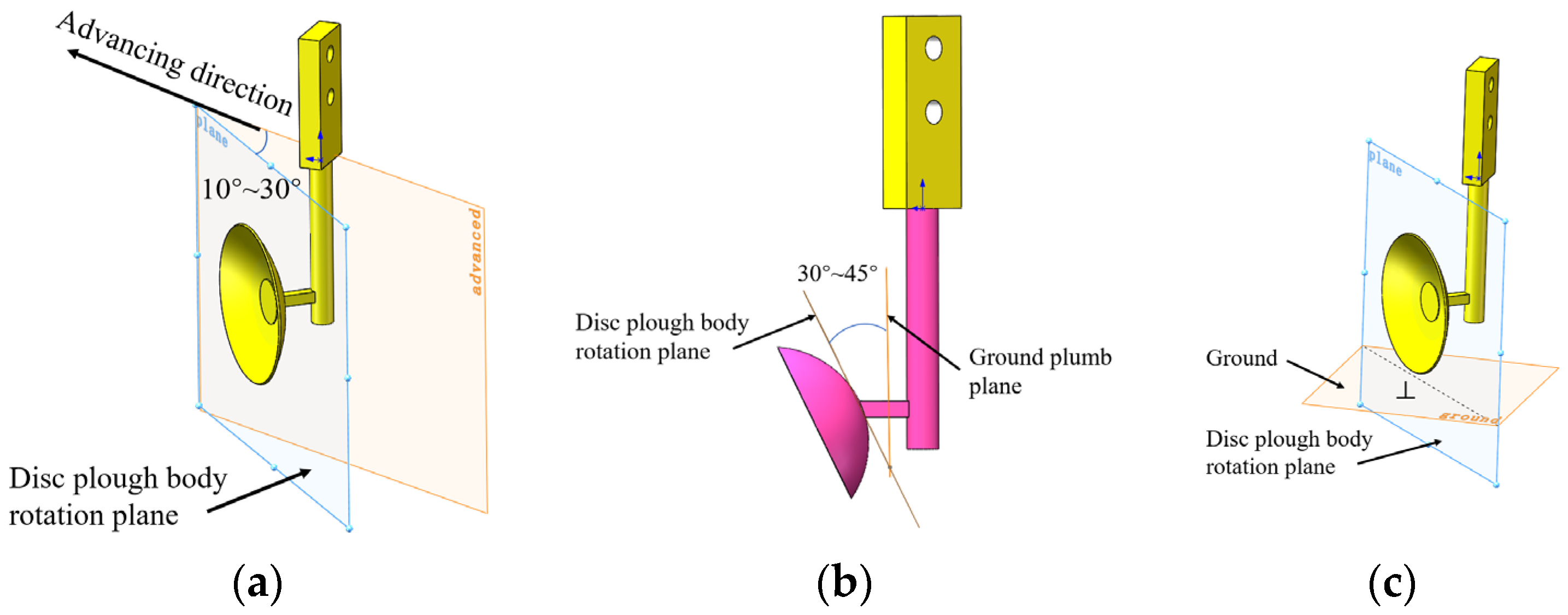
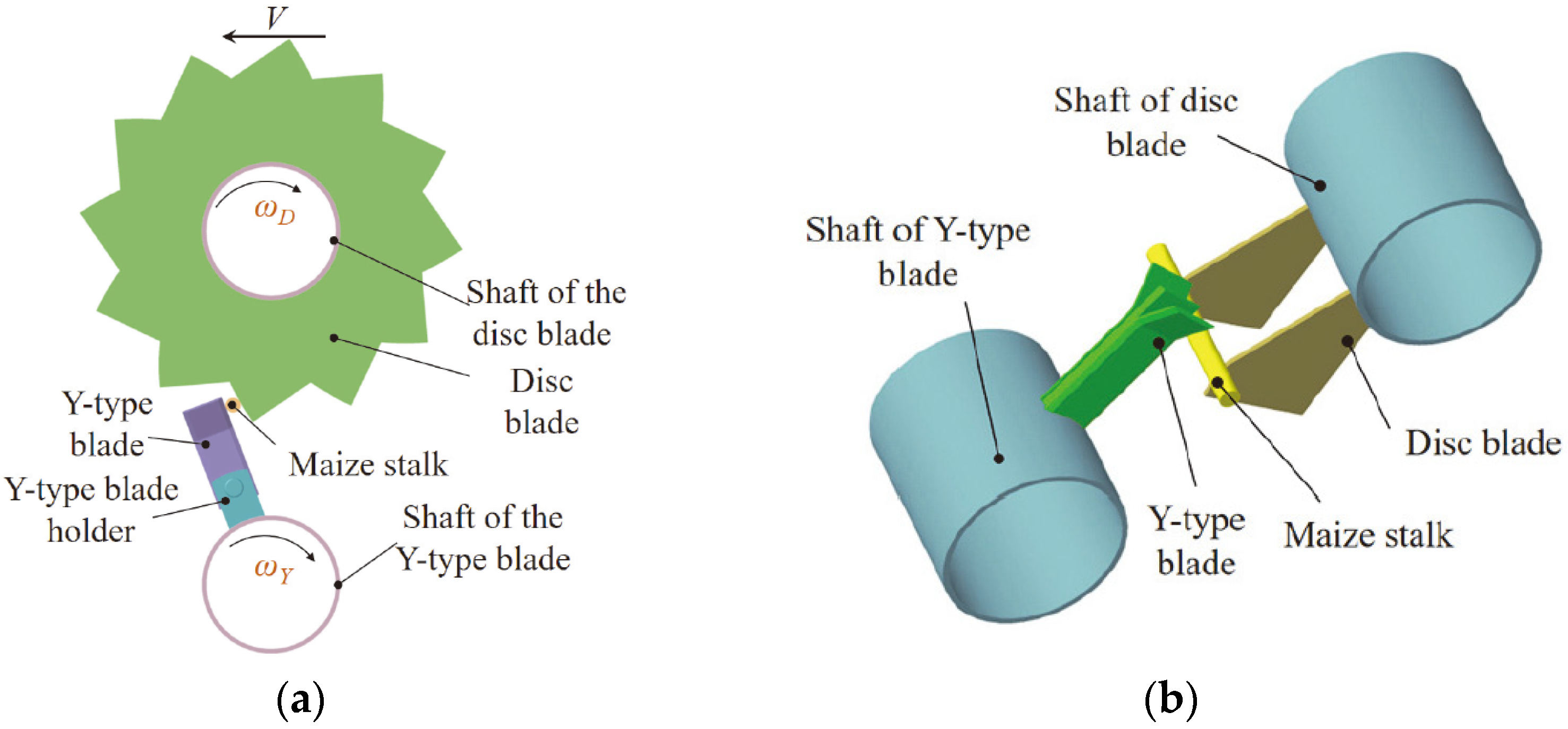


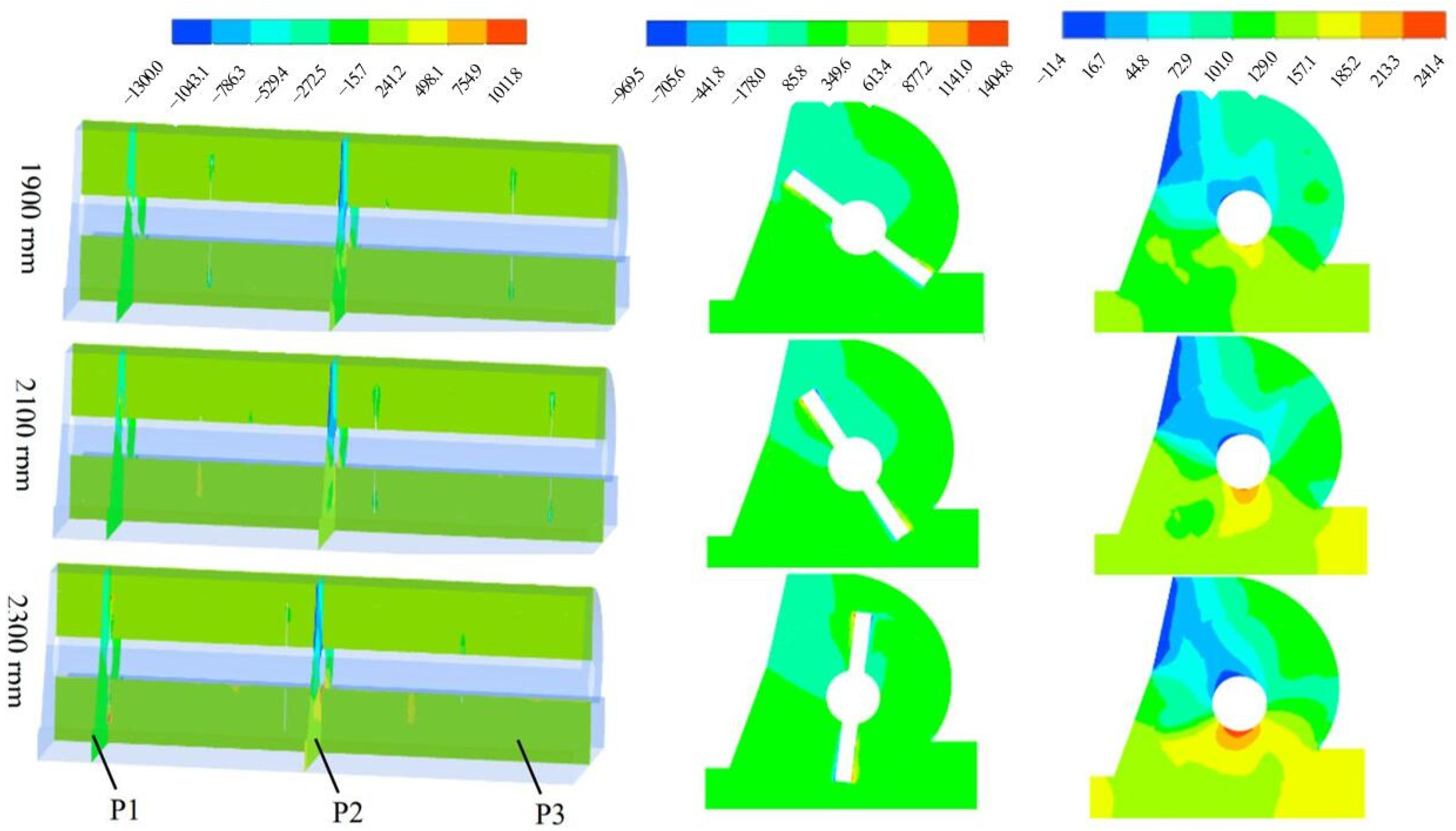
| Department | Regulation/Laws | Related Content |
|---|---|---|
| Ministry of Agriculture and Rural Affairs, National Development and Reform Commission, Ministry of Finance et al. [14] | Implementation Plan of the National Black Soil Protection Project (2021–2025) [14] | Promoting the return of crop straw and green manure to the field. |
| Ministry of Agriculture and Rural Affairs, National Development and Reform Commission, Ministry of Finance et al. [15] | Outline of Northeast Black Soil Protection Plan (2017–2030) [15] | Implementing straw returning to the field to protect the soil. |
| Ministry of Agriculture and Rural Affairs, Ministry of Finance [16] | Action Plan for Conservation Tillage of Black Soil in Northeast China (2020–2025) [16] | Increasing the application area of soil organic cover (crop straw). |
| Ministry of Agriculture and Rural Affairs [17] | Technical Guidelines for Green Agricultural Development (2018–2030) [17] | Promoting straw returning and organic matter returning technologies. |
| Central Document No. 1 [18] | State Council [18] | Promoting comprehensive utilization of straw. |
| Mulch Category | Field Photo | Main Crops | |
|---|---|---|---|
| Crop straw and residues |  |  | Rice; Wheat; Corn; Cotton; Banana; Tobacco; Soy Beans |
| Live mulch (crops) | 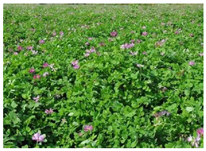 |  | Vicia villosa; Vicia sativa; Brassica campestris; Astragalus sinicus; Sesbania cannabina; Melilotus suaveolens; Astragalus; Raphanus sativus; Azolla imbricate |
| Working Type | Typical Machine | Company | Working Feature |
|---|---|---|---|
| Chopping and mixing machine | 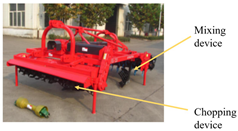 | Hebei Shuangtian Machinery Manufacturing Co., Ltd., Baoding, Hebei, China [25] | High-speed rotating blades chop the straw, evenly mixing organic mulch and soil. |
| Chopping and spreading machine |  | Hebei Lianhang Machinery Co., Ltd., Shijiazhuang, Hebei, China [26] | Moving and fixed knives support chopping; guide vanes adjust spreading parameters. |
| Chopping and burying machine |  | YTO group corporation. Luoyang, Henan, China [27] | No need to chop; bury organic mulch directly in the soil; the working depth is over 20 cm. |
 | No need to chop; Bury organic mulch directly in the soil; The working depth is between 10 and 20 cm. |
| Core Device | Common Form | Schematic | Features | |
|---|---|---|---|---|
| Spreader | Active | Disc diversion [34] |  | High spreading quality; real-time adjustment. |
| Pipeline [35] | 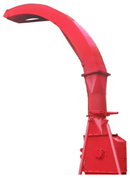 | Long spreading distance; real-time adjustment. | ||
| Passive | Tailboard diversion [22] | 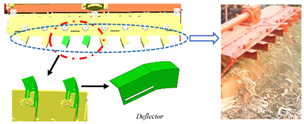 | Low fuel consumption; adjustable throwing width. | |
| Shell diversion [23] | 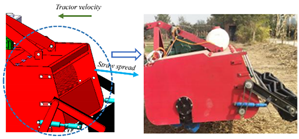 | Low fuel consumption; adjustable throwing amount. | ||
| Core Device | Common Form | Schematic | Features |
|---|---|---|---|
| Plow | Moldboard plow |  | Working depth: 12–20 cm; high fuel consumption. |
| Disc plow [45] |  | Working depth: 8–12 cm; high working speed. |
| Type | Schematic | Description | Advantages | Disadvantages | Applicable Machine |
|---|---|---|---|---|---|
| Straight [46] |  | Suitable for soft mulch such as wheat straw, rice straw, and most crops. | Good chopping quality; low fuel consumption. | Easily damaged. | Straw choppers and spreaders |
| Bent [47] |  | Suitable for hard mulch and soil chopping. | Good mixing quality. | Easily blocked; high fuel consumption. | Rotary tillers |
| E [48] |  | Suitable for hard mulch, such as banana straw. | Good chopping quality; high working efficiency. | Complex structure. | Straw choppers and spreaders |
| L [49] |  | Suitable for most mulch and soil chopping. | Good mixing quality; low fuel consumption. | Easily damaged. | Rotary tillers |
| T [50] |  | Multi-directional chopping; suitable for soft straw. | Low fuel consumption; simple structure. | Difficult to manufacture. | Rotary tillers |
| Y [51] |  | Suitable for hard crop straw (maize, sorghum); similar to Y type blade; barycenter locates on the symmetric line of the blade. | Good symmetry of the shape; large moment of inertia. | Short edge line; a large mass. | Straw choppers and spreaders |
| V-L [52] |  | Suitable for maize; a V-bending section is added on L-shaped blade; barycenter located in the same plane with blade handle. | Long operation life; good chopping quality; high work efficiency. | Complex shape; high machining requirements. | Straw choppers and spreaders |
| Hammer [53] |  | Suitable for hard crop straw (maize, cotton); usually made of high strength and wear-resistant cast steel. | Good chopping quality; long operating life. | High fuel consumption. | Straw choppers and spreaders |
| Type | Description | Features | Applicable Machine |
|---|---|---|---|
| Notched concave disc [58] | Suitable for soil and mulch with high moisture content; notches around the disc. | Good buried quality; provide greater force. | High-speed plow |
| Wave concave disc [59] | Suitable for soil and mulch with low moisture content. | Difficulty in manufacturing. | Low-speed plow |
| Ordinary concave disc [60] | Strong adaptability | Most commonly used discs; low manufacturing cost. | High or low-speed plow |
| Type | Scheme | Description | Features |
|---|---|---|---|
| Horizontal straight generatrix [62] | 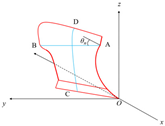 | AB: horizontal straight generatrix; CD: directrix; θn: straight generatrix angle. The surface is formed by the rotation of AB along CD. | Simple, convenient, and practical; good chopping quality. |
| Tilt straight generatrix [63] |  | AB: tilt straight generatrix; CD: directrix. | Good tillage performance; low tillage resistance. |
| Twist generatrix [63] |  | AA1B: twist generatrix; CC1: directrix. The surface is formed by the rotation of AA1B along CD. | Suitable for soil with high moisture content, such as a paddy field. |
Publisher’s Note: MDPI stays neutral with regard to jurisdictional claims in published maps and institutional affiliations. |
© 2022 by the authors. Licensee MDPI, Basel, Switzerland. This article is an open access article distributed under the terms and conditions of the Creative Commons Attribution (CC BY) license (https://creativecommons.org/licenses/by/4.0/).
Share and Cite
Lin, H.; He, J.; Li, H.; Li, H.; Wang, Q.; Lu, C.; Li, Y.; Jiang, S. A Review of Research Progress on Soil Organic Cover Machinery in China. Agriculture 2022, 12, 1311. https://doi.org/10.3390/agriculture12091311
Lin H, He J, Li H, Li H, Wang Q, Lu C, Li Y, Jiang S. A Review of Research Progress on Soil Organic Cover Machinery in China. Agriculture. 2022; 12(9):1311. https://doi.org/10.3390/agriculture12091311
Chicago/Turabian StyleLin, Han, Jin He, Hui Li, Hongwen Li, Qingjie Wang, Caiyun Lu, Yanjie Li, and Shaomei Jiang. 2022. "A Review of Research Progress on Soil Organic Cover Machinery in China" Agriculture 12, no. 9: 1311. https://doi.org/10.3390/agriculture12091311





